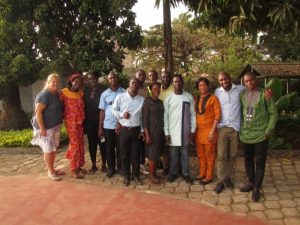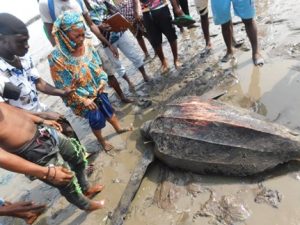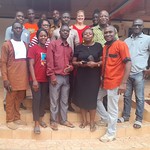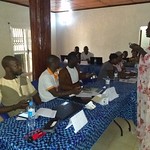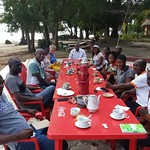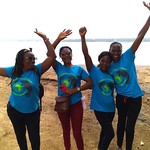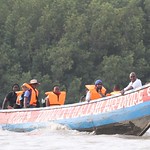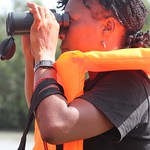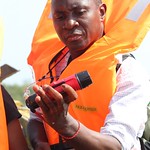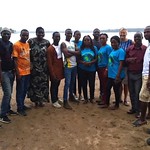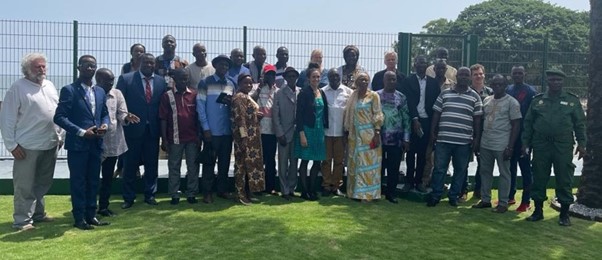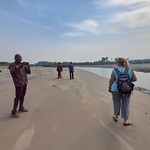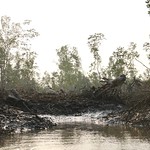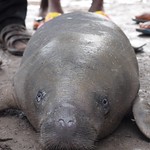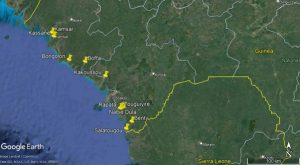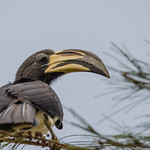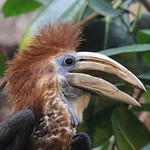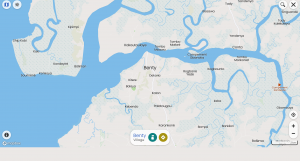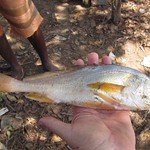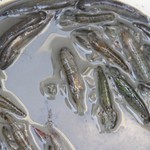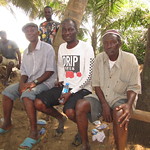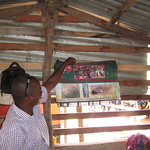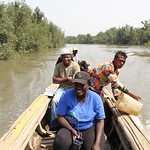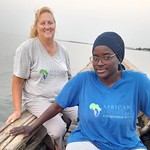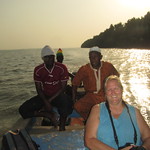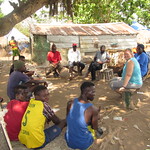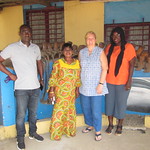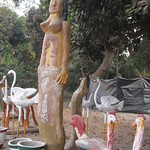Small Grant Login

0% of this project has been implemented.
March 1, 2021
September 30, 2024
Project Summary
Little is known about Guinea’s African manatees. The manatee live along the coast and also deep into the interior of Guinea’s Niger and Gambia rivers. This will be the first dedicated research and conservation project in Guinea to focus on African manatee. This project will train Guinean researchers in African manatee research and conservation techniques, while also conducting a threat assessment of all manatee habitat use areas of the country. Biological samples will be collected opportunistically and analyzed to provide the first information about manatee population genetics, feeding ecology and habitat use in Guinea. Threat assessment results will be shared with wildlife law enforcement and we will also work with them to encourage their enforcement of laws to protect the species. Education programs as well as TV, radio, newspaper and other media announcements will raise awareness of the need to protect the manatee.
Objectives
Research: Identify range, collect biological samples for DNA analysis, count population numbers, identify and mitigate threats.
Practice: Train local Guinean researchers in Manatee conservation best practices.
Outreach: Raise awareness of the need to protect the manatee through traditional and social media.
Key Documents
Project location - Guinea, Africa
Field Reports
Manatee workshop in Conakry
June 19, 2023
The third manatee workshop was held at the Centre Nationale des Sciences Halieutiques de Boussoura (CNSHB) in Conakry from 9-16 June 2023.
Guest speakers via Zoom included Jimmy Nzomba of Organisation Ecotouristique de Lac Oguemoué (OELO) in Gabon, who leads a very successful education and outreach program for Gabonese school children, and Ann Holmes who gave a presentation on environmental DNA and how to collect samples for analysis. Journalist Mouhamed Youra Bangoura gave a presentation in person about how to give effective media interviews.
On the first day of the workshop, the Guinea Manatee Fellows delivered spoken and scientific poster presentations to representatives from government ministries, universities, and various Guinean NGOs in Conakry. Each member had a 15-minute window to present to the 30 delegates comprising MBZ, the Ministry of Water and Forestry, Guinea national parks, and several Guinean universities.
For those from the Ministry of Environment who were unable to attend, PDFs of the presentations were shared to ensure they remained informed.
Additionally, Lucy met with the Deputy Minister of the Environment, Karim Samoura, who expressed significant interest in the program. The African Aquatic Conservation Fund remains committed to keeping him updated on the project’s progress.
Five new rivers for manatees discovered
June 9, 2023
A team led by Lucy Keith Diagne, along with journalist John Wendle, traveled inland to the Haut Niger region to conduct interview surveys and collect water samples for environmental DNA (eDNA) analysis from the Niger, Tinkisso, Niandan, Milo, and Sankarani Rivers.
The primary objective of the trip was to gather insights through interviews to determine whether manatees had been previously recorded in these waterways. While manatees were only briefly mentioned in the Niger and Tinkisso Rivers in Dodman et al. (2008) and not documented elsewhere, Lucy suspected that the significant tributaries of the Niger River could provide suitable habitat for manatees.
The trip yielded promising results: based on 61 interviews conducted across 17 locations, five new rivers were identified where manatees have been previously recorded.
Good progress as Manatee Fellows present results
February 15, 2023
The February workshop was held in Conakry at the Centre Nationale des Sciences Halieutiques de Boussoura (CNSHB) and attended by 13 Guinea Manatee Fellows, including four women. Topics covered included manatee rescue techniques as well as fundraising strategies.
Guest speaker Prof. Doumboya gave a lecture about Guinea’s marine protected areas, and CNSHB’s Mr. Kaba gave two presentations about effective communication and awareness raising methods.
Eight Fellows gave 15-minute presentations of their research conducted over the past 8 months.
The project continues to gain momentum with each Fellow receiving their next stipend (the equivalent of $600 USD in GNF) to continue their projects.
Fine and imprisonment for slaughtering Manatees
September 29, 2022
On the 1st September a dead male manatee was discovered by staff of the Ile de Tristao marine protected area. An autopsy could not reveal the cause of death, but it was not linked to poaching. Previously a poacher was arrested, convicted and sentenced to three months in prison and a fine of 30 million GNF ($3,500 USD). An additional three officials, who supported the poachers were suspended from their jobs and sentenced to a month in prison and undisclosed fines.
Workshop for Guinea Manatee Fellowship fieldwork training
May 26, 2022
At the workshop each fellow participant, either individually or with a partner, developed the in-depth manatee project they will undertake. These focused on either danger to manatees and raising awareness in the coastal zone or investigating regions of the Guinea’s interior to determine where manatees are present and documenting any threats. Each trainee received their field equipment including GPS unit, depth sounder, Secchi disk, binoculars, point and shoot camera, refractometer, waterproof backpack, and rain jacket. They also received manatee awareness stickers, electronic copies of all workshop presentations, African manatee scientific literature, and standard forms for interviews and necropsies. The trainees will now be implementing their projects and will then provide an update on their fieldwork progress at the next training workshop to be held in February 2023.
Guinea Manatee Fellowship introductory training begins
May 16, 2022
After careful selection, based on prior academic and professional conservation biology and fieldwork experience, 13 candidates have been chosen as Guinea Manatee Fellowship (GMF) trainees. Each fellow made a brief introduction about their previous conservation and/or biological research work, and the two fellows who have previously carried out manatee work in Guinea gave presentations.
The first workshop started on 16 May with presentations on manatee biology and evolution, ecology, genetics, and necropsy procedures. The trainees were then taught how to take standard measurements of manatees, to use a GPS unit, to collect and store genetics and other biological samples, and techniques on how to lead non-biased interviews. They then left the classroom to put the teaching into practise with two days of interview surveys in the villages of Wawa and Kakoussou and two boat surveys on the Konkoure River.
Click the thumbnail to enlarge it and read the captions
Event for Mubadala funded species conservation projects in Guinea
May 12, 2022
In Conakry, NGO Biotope hosted an event attended by stakeholders, government representatives and teams from all three Mubadala funded projects in Guinea (manatees, Atlantic humpback dolphins and sea turtles). During the manatee presentation, discussions covered the protected status of the species, threat assessment, planned training and educational outreach work. The event provided an excellent opportunity to present the African manatee project and to answer all questions by government and NGO participants.
Human threats to the Guinea’s manatee revealed
February 28, 2022
Following approval of the scientific research permit from the Ministry of Water and Forestry, a survey was conducted via boat, with interviews at fishing camps, villages and ports along the routes. Stated threats to the Manatee from human activity included by-catch in fishing gear, direct hunting, noise pollution from large ships, injury from boats, and habitat destruction through the cutting of mangroves and port construction. It also reported that manatees were being killed in retaliation for stealing fish from nets and for raiding rice fields.
Researchers strengthened by essential equipment
February 21, 2022
Research and capacity-building equipment has been purchased to assist our biologists and to enable the conduct of surveys for the manatee project in Guinea. Items bought included GPS units, binoculars, hard drives for data storage and waterproof clothing and backpacks. Supplies also included necropsy equipment to help our team to understand more about how the manatee is affected by disease and human interactions.
Hornbills sighted in unspoiled mangrove
February 12, 2022
Travelling to the north of Benty village our team came across the most pristine and mature mangrove among all of the areas surveyed. There they discovered an amazing diversity of bird life including the African Pied Hornbill and Yellow-casqued Hornbill, which were not sighted anywhere else on the Guinea coast.
Potential discovery: Manatees in Guinea might eat crayfish
February 11, 2022
Lucy Keith Diagne, Manatee Project Lead: “Here are some photos from our recent fieldtrip to Guinea. The photos are primarily from boat surveys and interviews we did, but also of a new fish species reportedly eaten by manatees, as well as small crayfish fishermen told us they are eating in the mud. The crayfish are particularly interesting because although we have reports of manatees eating mollusks in the mud throughout Africa, we’ve never heard about the crayfish before, but I’ve also never encountered them anywhere before. I’m also including a photo from our day at the Centre National des Sciences Halieutiques de Bousourra at the beginning of the trip, and a photo of the head of the port of Kamsar showing where he will post the manatee awareness poster we gave him.”
Its been a great month!
January 31, 2022
Dispatch from Dr Lucy Keith-Diagne, principle investigator for the manatee and dolphin projects in Guinea:
I’m now back in Conakry after a very successful few weeks traveling the entire littoral region of Guinea from Kamsar to Benty. We got lots of good information about manatees and their threats from our interviews, we had one manatee sighting and two sightings of Humpback dolphins. Also before we left Conakry at the beginning of the month we had meetings with CNSHB, Guinee Ecologie and Biotope, and we had two Guinean researchers on field trips with us. I’ve identified potential candidates for the manatee research training that I’ll begin in May.
It’s been a great month. This morning I’ve been invited to meet with Mr. Amadou Diallo, the incoming Chair of the International Whaling Commission and incoming President of COMHAFAT (ATLAFCO | Welcome (comhafat.org)), to talk about the manatee and Atlantic humpback dolphin projects. Another expert from CNSHB has also been invited to the meeting. Unfortunately we didn’t get any photos of the manatee (it surfaced once very quickly and then not again) nor the dolphins (which stayed very far ahead of the boat, so we only saw their splashes and one hump surface very briefly), but we did get GPS coordinates of the locations.

















